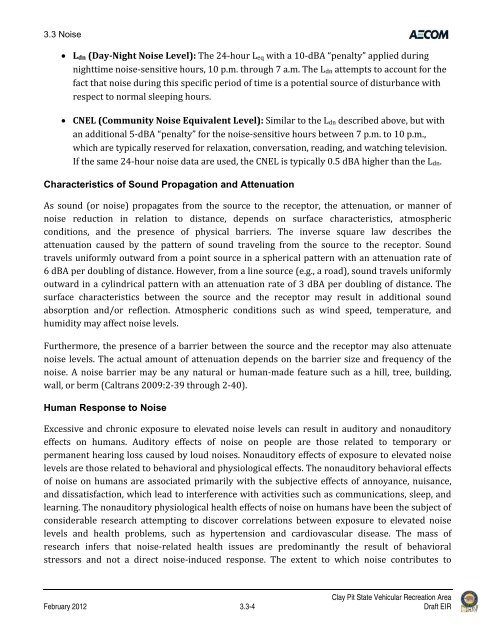Draft Environmental Impact Report - California Off Highway Vehicle ...
Draft Environmental Impact Report - California Off Highway Vehicle ...
Draft Environmental Impact Report - California Off Highway Vehicle ...
You also want an ePaper? Increase the reach of your titles
YUMPU automatically turns print PDFs into web optimized ePapers that Google loves.
3.3 Noise<br />
Ldn (DayNight Noise Level): The 24‐hour Leq with a 10‐dBA “penalty” applied during<br />
nighttime noise‐sensitive hours, 10 p.m. through 7 a.m. The Ldn attempts to account for the<br />
fact that noise during this specific period of time is a potential source of disturbance with<br />
respect to normal sleeping hours.<br />
CNEL (Community Noise Equivalent Level): Similar to the Ldn described above, but with<br />
an additional 5‐dBA “penalty” for the noise‐sensitive hours between 7 p.m. to 10 p.m.,<br />
which are typically reserved for relaxation, conversation, reading, and watching television.<br />
If the same 24‐hour noise data are used, the CNEL is typically 0.5 dBA higher than the Ldn.<br />
Characteristics of Sound Propagation and Attenuation<br />
As sound (or noise) propagates from the source to the receptor, the attenuation, or manner of<br />
noise reduction in relation to distance, depends on surface characteristics, atmospheric<br />
conditions, and the presence of physical barriers. The inverse square law describes the<br />
attenuation caused by the pattern of sound traveling from the source to the receptor. Sound<br />
travels uniformly outward from a point source in a spherical pattern with an attenuation rate of<br />
6 dBA per doubling of distance. However, from a line source (e.g., a road), sound travels uniformly<br />
outward in a cylindrical pattern with an attenuation rate of 3 dBA per doubling of distance. The<br />
surface characteristics between the source and the receptor may result in additional sound<br />
absorption and/or reflection. Atmospheric conditions such as wind speed, temperature, and<br />
humidity may affect noise levels.<br />
Furthermore, the presence of a barrier between the source and the receptor may also attenuate<br />
noise levels. The actual amount of attenuation depends on the barrier size and frequency of the<br />
noise. A noise barrier may be any natural or human‐made feature such as a hill, tree, building,<br />
wall, or berm (Caltrans 2009:2‐39 through 2‐40).<br />
Human Response to Noise<br />
Excessive and chronic exposure to elevated noise levels can result in auditory and nonauditory<br />
effects on humans. Auditory effects of noise on people are those related to temporary or<br />
permanent hearing loss caused by loud noises. Nonauditory effects of exposure to elevated noise<br />
levels are those related to behavioral and physiological effects. The nonauditory behavioral effects<br />
of noise on humans are associated primarily with the subjective effects of annoyance, nuisance,<br />
and dissatisfaction, which lead to interference with activities such as communications, sleep, and<br />
learning. The nonauditory physiological health effects of noise on humans have been the subject of<br />
considerable research attempting to discover correlations between exposure to elevated noise<br />
levels and health problems, such as hypertension and cardiovascular disease. The mass of<br />
research infers that noise‐related health issues are predominantly the result of behavioral<br />
stressors and not a direct noise‐induced response. The extent to which noise contributes to<br />
Clay Pit State Vehicular Recreation Area<br />
February 2012 3.3-4 <strong>Draft</strong> EIR








